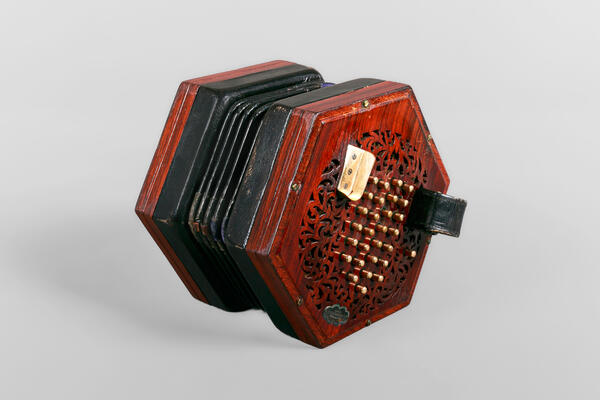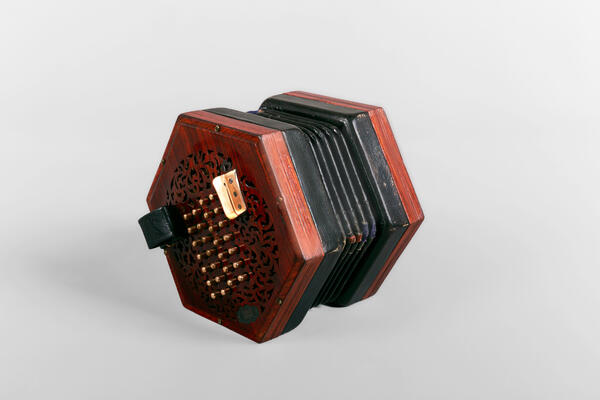The concertina is a free-reed musical instrument, a squeezebox with a chromatic scale. It was invented by the English physicist Sir Charles Wheatstone in 1827 who patented his design in 1829.
His father worked at a music store and later became a flute teacher. In 1821, at the age of 19, Charles Wheatstone invented the “Acoucryptophone, ” or the “Enchanted Lyre.”
He exhibited the Acoucryptophone at his father’s shop. It consisted of a lyre figure that hung from the ceiling and was connected by a copper wire to a piano or a harp, conveying their vibrations and emitting their sounds. The visitors were amazed by the unique device because the instruments themselves were played out of sight.
Wheatstone created the concertina based on the German harmonica. The design was so successful that it existed for over a century without undergoing significant changes. In later versions, the instrument’s range was extended, and concertinas of different registers were designed.
The concertina from the collection of the Russian National Museum of Music has a range that spans four octaves. Instead of keys, it has four parallel rows of buttons on each side. The buttons produce the same notes regardless of the changes in the direction of air pressure.
The notes that are drawn on the lines of a staff are played by the left hand on the lower keyboard, while the notes located on the spaces are played on the upper keyboard. The musicians play with the index, middle, and ring fingers while supporting the instrument with their thumbs and little fingers.
The instrument was brought to Russia in the late 1870s. The Russian music teacher Grigory Marenich introduced the use of concertina at the Mariinsky Institute for Women in Saint Petersburg. In the 1880s, the Society of English Concertina Players was established in Russia.
In 1889, the concertina player Isaak Pirozhnikov attempted to create the first concertina orchestra at the Vilnius Teacher Institute. He also published a brochure on the design and advantages of the concertina.
In the 20th century, the concertina became popular as the instrument for satirical songs. Contemporary concertinists include Valentin Osipov, comedians Nikolay Bandurin and Gennady Vetrov.
His father worked at a music store and later became a flute teacher. In 1821, at the age of 19, Charles Wheatstone invented the “Acoucryptophone, ” or the “Enchanted Lyre.”
He exhibited the Acoucryptophone at his father’s shop. It consisted of a lyre figure that hung from the ceiling and was connected by a copper wire to a piano or a harp, conveying their vibrations and emitting their sounds. The visitors were amazed by the unique device because the instruments themselves were played out of sight.
Wheatstone created the concertina based on the German harmonica. The design was so successful that it existed for over a century without undergoing significant changes. In later versions, the instrument’s range was extended, and concertinas of different registers were designed.
The concertina from the collection of the Russian National Museum of Music has a range that spans four octaves. Instead of keys, it has four parallel rows of buttons on each side. The buttons produce the same notes regardless of the changes in the direction of air pressure.
The notes that are drawn on the lines of a staff are played by the left hand on the lower keyboard, while the notes located on the spaces are played on the upper keyboard. The musicians play with the index, middle, and ring fingers while supporting the instrument with their thumbs and little fingers.
The instrument was brought to Russia in the late 1870s. The Russian music teacher Grigory Marenich introduced the use of concertina at the Mariinsky Institute for Women in Saint Petersburg. In the 1880s, the Society of English Concertina Players was established in Russia.
In 1889, the concertina player Isaak Pirozhnikov attempted to create the first concertina orchestra at the Vilnius Teacher Institute. He also published a brochure on the design and advantages of the concertina.
In the 20th century, the concertina became popular as the instrument for satirical songs. Contemporary concertinists include Valentin Osipov, comedians Nikolay Bandurin and Gennady Vetrov.





